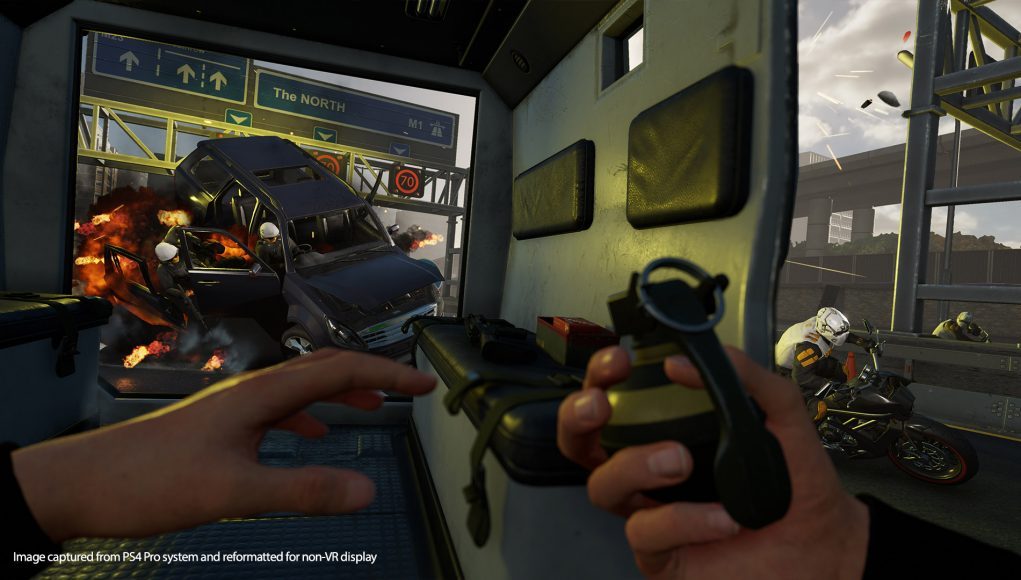Sony’s next big PSVR exclusive, Blood & Truth is finally here. This action adventure aims to make players feel like the lead character in an action movie, and brings strong gunplay and big set pieces to the table. But its biggest contribution might just be the performances and visuals of the game’s virtual characters which are the best we’ve ever seen in VR.
Blood & Truth Details:
Developer: SIE London Studio
Available On: PSVR [Exclusive] (digital, physical)
Reviewed On: PS4 Pro
Release Date: May 28th, 2019
Price: $40
Gameplay
Though Blood & Truth features plenty of shooting, I’d classify it as an ‘action adventure’ more than a pure ‘shooter’ because of the way it guides you through a purposeful narrative. The gameplay is largely defined by its locomotion, which (for Sony’s first-party studios) is relatively ambitions. It uses node-based smooth locomotion, meaning there are predefined places you can go, but instead of teleporting, you slide smoothly from one node to the next. It isn’t entirely on-rails, but it feels pretty close because there isn’t that much variety in where you can go (even though it opens up slightly later in the game).
And while some might assume that this movement system was a necessary concession due to the lack of thumbstick on the Move controllers, I would argue that even if the controllers had thumbsticks, it’s an effective and smart design choice for the kind of game that London Studio set out to build. Not needing to worry so much about controlling your large-scale movement frees you up to focus on shooting and doing other things when moving between points, as well as focusing on your small-scale movements (leaning around corners and boxes). In the end, it works in service of a game that’s all about setting up action and set piece moments.
Gunplay and handling is also suitably refined. Instead of a complex inventory system, Blood & Truth gives you two handgun holsters at your hips and two heavy weapon holsters over your shoulders. Ammo is drawn from a satchel at your chest; a fresh magazine for whichever gun your holding is always there ready and waiting to be pulled out and stuck into your weapon. It’s an effective system, which—like the game’s locomotion—cuts out complexity in favor of focus.
Shooting feels good pretty much across the board thanks to a combination of good effects and sounds, though which weapon you choose doesn’t often significantly change your playstyle. You can aim down sights for precision, but ammo is plentiful enough, that unless you’re going for stealth headshots or long-range kills, you’re usually fine just roughly eyeing things up and spraying down range. There’s not a huge array of weapons, and even though you get access to some bigger guns later in the game, all of the weapons continue to feel valid throughout.
The game also includes some light weapon customization; you’ll be able to visit a safehouse where you can decide which weapons you want to carry into the next level. You can add a few attachments to each gun, and apply different paint jobs, all of which are unlocked with ‘star’ points collected across the levels by shooting hidden targets or finding other collectibles. The attachments—like scopes and silencers—don’t feel very consequential to the gameplay, but configuring your loadout and weapons is a smart bit of interactive downtime between all of the shooting.
Unfortunately enemies aren’t particularly varied, and rarely require prioritization or unique tactics. Most enemies are taken down most effectively the same way: just put plenty of bullets into them, preferably in the head region. The only exception is the relatively rare ‘heavy’ enemies that have riot shields; they can be most easily dispatched by activating the game’s slow-motion function (by pressing both Move buttons) that then shows little white targets on the enemy, which can be hit in succession for a quick takedown.
It feels like the VR equivalent of a quick-time event, and is generally pretty fun to do, but it also feels somewhat out of place with the rest of the gunplay. You can activate slow motion at any time actually, and while it can lead to some cool visual moments (as bullets, particles, and bodies go flying in slow-mo), it’s ultimately ancillary to the overall gameplay.
Luckily, Blood & Truth’s gunplay doesn’t overstay its welcome, thanks to it being spaced out by more intricate activities (like lock picking and climbing), action set pieces, and narrative sequences.
The action set pieces are fun, and essential to preventing Blood & Truth from inching toward wave shooter land, although few of them felt particularly memorable, which is probably because most are highly scripted, and don’t leave much room for the player to influence the outcome.
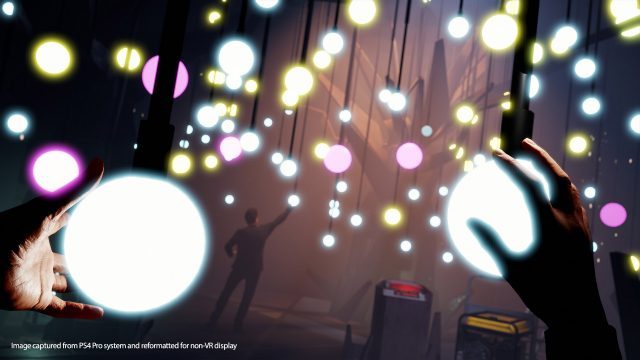
Actually, one of the more memorable set pieces in the game wasn’t driven by action (and, indeed, gave the player more agency)—part of the game sees the player sneaking into a modern art museum, which London Studio used as a genius way to pepper the game with some quite cool VR moments that otherwise wouldn’t have made much sense in the context of Blood & Truth.
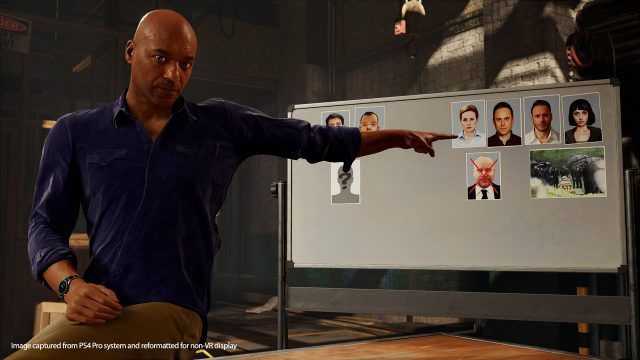
But beyond the set pieces are the game’s truly unmatched virtual characters which deliver the game’s narrative and provide some reason behind the action. With photogrammetry, motion capture, and smart design, London Studio has raised the bar for virtual characters at a scale not seen in any VR game to date. The work they’ve done in this area is very likely to become a staple of future AAA VR games. Let’s talk about that (and more) in the Immersion section below.
And a quick note on game time: it took me about 4 hours and 20 minutes to complete the Blood & Truth campaign. And while that might seem on paper like a relatively short experience, I have to say that it felt quite a bit longer, probably because the game was very engaging didn’t feel like any of its mechanics overstayed their welcome. I applaud London Studio for not padding game time with more shooting segments, and instead making sure that each hour of gameplay has meaningful fun for the player.
Sony says the game includes some ‘time attack’ challenges, but this mode wasn’t available at the time of our review. In future updates, London Studio plans to add leaderboards (which will rank you based on a score given for each level), a New Game+ option (which will let you play the campaign with all of your unlocked weapons and attachments), Hard Mode (a higher difficulty level), as well as “additional challenge modes […] plus much more.”
Immersion
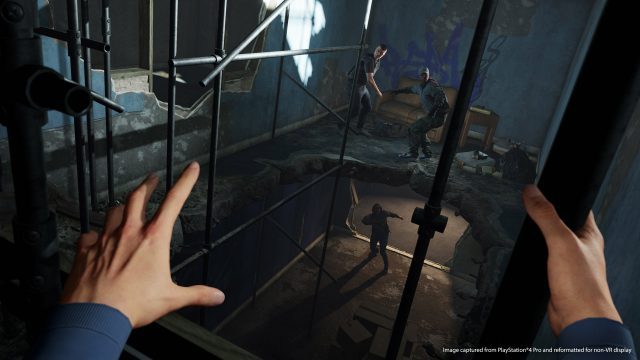
So let’s talk about Blood & Truth’s story and virtual characters. The characters are the primary drivers of the story, which starts out very personal, but wanes later in the game as it eventually relies on a nebulous secret organization as the reason why everything is happening. I found the monolithic ‘evil cabal’ trope a distraction from the much more personal story of two warring crime families.
Still, the characters themselves are really something to behold. Driven by a cast of talented actors (mediated by an excellent technical pipeline for representing faces and motions in VR at high fidelity), they look at sound great. In many of the game’s sequences, characters are acting right in front of the player, often speaking to you directly. They make correct eye contact, and the fidelity of their performance and visuals is just so good that it’s hard to not be interested in what they’re saying. In addition to excellent performance capture, the attention to detail on their varied outfits is top-notch, with convincing textures, folds, and lighting (especially the leather jackets).
Though hampered by a story that isn’t terribly memorable, the characters are used to mostly strong effect, especially in a sequence later in the game where one character doesn’t mind getting in your face. The writing and dialogue are mostly good, though your chummy rapport with most other male characters can be overbearing (par for the ‘action movie’ vibe, I suppose), but at least occasionally feels authentic.
Blood & Truth’s release is a bar setting moment for virtual characters and narrative exposition in a VR game, at least at this scope and scale.
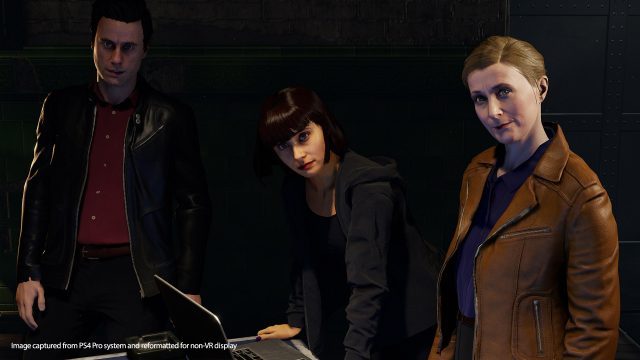
London Studio’s efforts here really drive home how (when it comes to immersion) great content is the single most important factor. Even though PSVR’s visuals are quite lagging behind newer PC headsets, and even though PS4 Pro doesn’t have the power of a high-end gaming PC, Blood & Truth’s virtual character’s are so well rendered that it’s easy to forget about all of that and become feel totally engrossed with what’s in front of you.
However, there were a few missed opportunities, mostly involving interactivity with the characters. There’s only one moment I recall where you have an opportunity to make interactive contact with another character (a handshake), but several moments which felt like interactivity was missing. With character performances heavily driven by motion capture, I can certainly appreciate the technical challenge of building real interactivity into narrative sequences, but I hope London Studio can tackle that challenge in future titles.
Immersion levels generally for Blood & Truth are pretty high throughout. Although the narrative moments lack interactivity, there’s a good bit of it peppered elsewhere in the game. The game’s node-based movement system is smart not only for the reasons discussed in the Gameplay section (above) but also because it means that London Studio can put interactive items within arms reach at various nodes without the impossible challenge of making every object and item in the game interactive.
There’s a good range of items to find and grab throughout, from objectives and optional collectibles, to pointless (but still appreciated) objects like beer bottles which can be broken, cookies which can be eaten, and sunglasses which can be worn. It’s usually obvious what can and can’t be grabbed, which helps avoid those immersion-breaking moments where you reach for something and your hand inexplicably slips through it.
There’s also interactive moments and mechanics that are necessary to keep moving forward. For instance, players will often have to pick locks, climb ladders, complete small electric hacking puzzles, or climb through vents.
All are suitably interesting, and smart way to pace combat moments, but not as seamlessly integrated into the broader gameplay as I would have hoped. Lockpicking for instance is just a roadblock. There was never a moment in the game where I had to pick a lock under pressure (like to escape a dangerous situation).
In the gun-handling department, there’s a number of nice immersive touches. Every gun in the game can be two-handed. Even with pistols, if you bring your non-dominant hand close to your main hand, the hands will animate into a two-handed pistol grip, and I often found myself doing this naturally. Larger weapons are gripped by the foregrip, and for some of the larger weapons this seems to decrease recoil. There’s also some fun extras in the handling department: if you hold ‘triangle’ with a pistol, you can spin your gun around your finger like a badass gunslinger; if you’re using the revolver, you can put your off-hand up to the hammer, which lets you shoot faster (as if you’re fanning). Maybe there’s some others I haven’t found?
Comfort
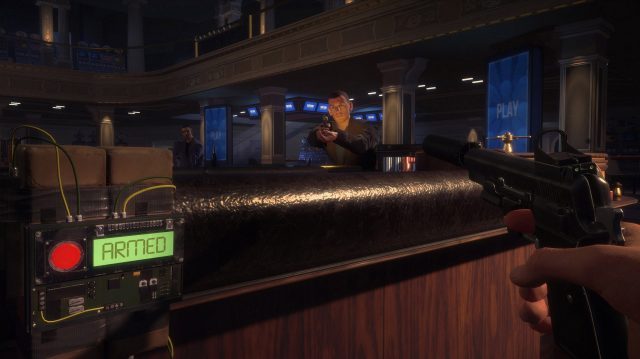
I found Blood & Truth to be very comfortable throughout. The node-based smooth movement system seems to work very well, and is much more immersive than if it relied on teleportation instead. An optional Comfort Mode reduces some effects and adds peripheral blinders during movement.
Though it’s comfortable and generally works well, the node-based system does prevent you from backtracking at all (even if you turn completely around, previous nodes will no longer be active), which can be a little annoying. While during most of the time you’ll be looking at the node you want to go to and clicking the Move button, there’s also dedicated staffing buttons which will move you to any nodes that are adjacent. I didn’t find it uncomfortable (from a vestibular standpoint) to move sideways like this, but it did feel a bit awkward at times.
The game’s holster and reload system is generally pretty good, and at the start of the game you can calibrate where your hip holsters and ammo pouch should be, which is a nice touch. Still, it can be fiddly at times. The game is designed to be played seated, and I would sometimes find that my holsters were ‘in’ my couch, causing me to shoot when I tried to holster my weapon with the trigger (because I couldn’t get close enough to the holster). I would have raised them up to abdominal height rather than hip height to avoid this, but calibration only allows a horizontal adjustment. Sitting upright and at the edge of my couch help prevent this, though sitting in an armless chair would likely be the ideal.
You can easily pass guns from one hand to another (by reaching your non-dominant hand to the weapon grip and pulling the trigger) which is really practical, but if you do this accidentally in the heat of the moment (because shooting and swapping guns both use the trigger) it can be a little confusing. This also lends itself to some confusion when it comes to swapping weapons in the middle of missions.
You’ll frequently come across different guns in the midst of a mission, but they instantly replace the weapon that corresponds to whichever hand you pick the weapon up with. For instance, if I pick up a pistol with my left hand, it will automatically become associated with the left pistol holster. Occasionally though, if I want a weapon in my left holster that’s sitting to my right, it can be awkward (if not simply too far away) to try to reach over and grab the gun with my left hand. It might be possible to actually grab the nearby weapon with the most convenient hand and then pass it to your other hand and then holster it that way, but I’m actually not sure—which is the crux of the issue; the way weapons are assigned to hands and holsters isn’t spelled out very clearly, so I was just figuring it out as I went.
A few weapons in the game have scopes that zoom, but they are very small and generally hard to look through; arguably they are more effective without the scope attachment. London Studio could have looked to games like Farpoint for better ideas for how scopes should work in VR. While the non-zoom scopes on weapons like pistols and the SMG were less of a hassle, they too could have been made easier to use (first by making them larger). Furthermore, two-handed weapons (especially the pump shotgun) could be really awkward to use when enemies were far to your off-side because you can’t rotate your torso when seated to face them properly with a two-handed weapon grip. I also found that the pump on the foregrip on the pump shotgun would occasionally pop out of my hand; the game seemed to want me to reach much further forward for the ideal foregrip position than was comfortable for me.

